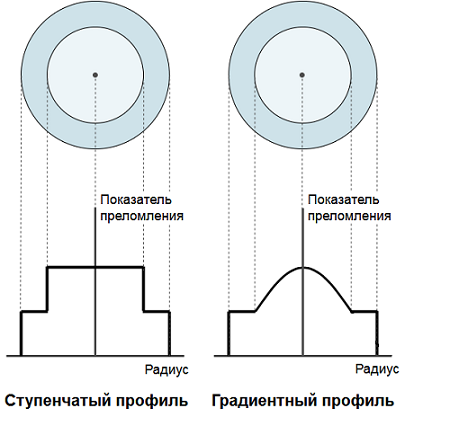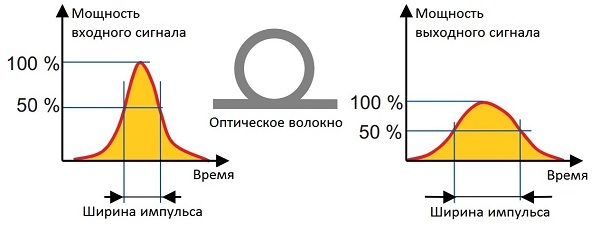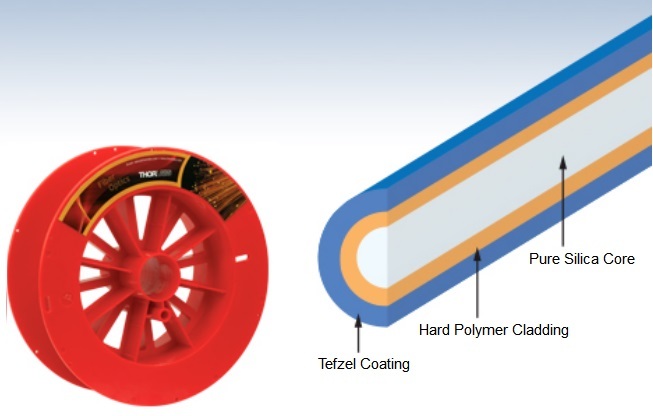Optical fibers for telecommunications: quartz and not only
From time to time on Habré appear various articles on the topic of fiber-optic communication lines (FOCL), which is not surprising, since optical communication today is one of the main ways of transmitting information. Optical communication lines successfully compete with traditional copper lines and wireless technologies. It is to the optical fiber that we owe a great deal to the sharp increase in the volume and speed of information transmitted throughout the world in recent years and, in particular, to the development of the Internet. Moreover, every year the optical fiber is getting closer to the consumer and is developing new areas of application.

We are sure that every self-respecting IT specialist should have at least a general understanding of fiber optic links, regardless of what exactly he does. The article offered to your attention is devoted to the types and classification of optical fibers . Of course, now you can easily find a lot of different information on this topic. But, as you will see further, and we have something to tell. Moreover, on Habré, while the topic of optical fiber is not sufficiently illuminated, it seems to us.
But first, a little about yourself
The company "EFO" has been supplying imported electronic components to the Russian market since 1991. For the past 15 years (since 2001), our supply program includes fiber optic and optoelectronic components. Historically, our main customers are representatives of various industries.
"EFO" has several specialized sites for different product groups. Optical communication is dedicated to the site infiber.ru , which is engaged in the staff of the Department of fiber-optic components. The site contains a catalog of fiber-optic products that we supply. Also here are published the news of manufacturers and articles written by employees of the department. Our site is created recently, but is actively developing.
The purpose of this article
As already mentioned, in this article we wanted to tell not so much about the optical fiber itself, but about its types and classifications. Most readers most likely know the difference between single-mode and multimode, but we want to give more detailed information so that you can easily navigate the variety of modern fibers and their properties and have no difficulty with the questions that arise in practical work, for example:
- What does OM4 mean in optical fiber specifications and how does it differ from OM1, OM2 and OM3?
- What materials are used in the production of fibers and cables? What is plastic optical fiber?
- Where should an offset dispersion fiber be used and in which cases should the dispersion be zero?
- What do abbreviations POF and HCS (PCS) mean?
The experience of communicating with customers shows that these and other things related to the classification of fibers are far from being known to everyone (we recall that our clients mainly work in industry and most often are specialists each in their field). Therefore, we believe that such information will be extremely useful. We hope very much that with one article our joint discussion on the topic of fiber optic links at Habré will not end.
Looking ahead a bit, we note that one of the main features of this article is that readers are familiar with POF and HCS fibers, because 1) these fibers are gaining increasing popularity in industry and other fields and 2) unlike traditional quartz fibers, they are not so good covered in the Russian-language Internet.
And the last. Recently, we have posted on our website five articles , which describe in more detail about the optical fiber and its main types. To whom the information outlined below is not enough, welcome to our site!
Optical fiber and its main characteristics
Based on the task (to provide a classification of optical fibers), we would not like to go deep into the theoretical foundations of fiber-optic communication. But in order for information to be understandable to a wide circle of readers, let us begin all the same with what constitutes an optical fiber, how a signal is transmitted through it, and what its some basic characteristics are.
Optical fiber (optical fiber) is a waveguide with a circular cross section through which electromagnetic radiation of the optical range (usually near infrared and visible light) is transmitted. Optical fiber consists of two main parts: the core and the optical cladding. The diameter of this structure is comparable to the thickness of a human hair. A protective acrylic coating is applied on top of the fiber. For further protection, various reinforcing and protective elements are used. A design containing one or more optical fibers and various protective elements covered with a common sheath is called a fiber-optic cable .

The information signal is transmitted through the optical fiber in the form of modulated light radiation. Due to the phenomenon of total internal reflection (remember the school course of geometrical optics), the light caught in the optical fiber propagates over it over long distances. The core and the optical cladding of the fibers are made of materials with slightly different refractive indices (the refractive index of the core is larger). Therefore, the light waves trapped in the core at angles less than a certain critical value, repeatedly reflect from the shell. If the conditions for propagation in the waveguide are fulfilled (light is not only a stream of particles, but also an electromagnetic wave), then such light waves, called modes , propagate over considerable distances.

In addition to the difference between the refractive indices of the core and the cladding, an important role is played by the profile of the refractive index of the core, that is, the dependence of the magnitude of the refractive index on the radius of the cross section of the optical fiber. If the refractive index remains the same at all points of the core section, such a profile is called a stepped one , and if it gradually decreases from the central axis to the shell, it is called gradient . There are more complex profiles. The profile of the refractive index has a great influence on the characteristics of the optical fiber as an information transmission medium.

Among the large number of characteristics and parameters describing an optical fiber as a data transmission medium, we note the most important ones: attenuation (loss) and dispersion.
Attenuation is the gradual attenuation of the optical signal power as it propagates through the fiber, caused by different physical processes. The attenuation value has a complex dependence on the radiation wavelength and is measured in dB / km. Attenuation is one of the main factors limiting the transmission distance of a signal through an optical fiber (without retransmission).
Dispersion is the broadening of an optical pulse transmitted over a fiber over time. At a high pulse repetition rate, such widening at a certain distance from the transmitter leads to the overlapping of adjacent pulses and erroneous data reception. Dispersion limits both the range and the speed of information transfer.

Types and classification of optical fibers
Having told (or having reminded) the reader about these basic concepts, let us proceed to the point at which all this was described, to the classification of optical fibers. There are a huge number of different optical fibers, so we immediately make a reservation that we will not deal with the so-called special fibers used in scientific research and various specific applications, as well as fibers that are more likely the technologies of the future. We will focus on those types of optical fibers that are already widely used in telecommunications today. And there are four such types.
The main criteria for classification are the following two:
- The material from which the core is made and the optical envelope. Optical fiber can be made not only from quartz glass, but also from other materials, in particular from polymers.
- The number of propagating mod . Depending on the geometric dimensions of the core and the cladding and the value of the refractive index in the optical fiber, only one or a large number of spatial modes can propagate. Therefore, all optical fibers are divided into two large classes: single-mode and multimode .
Thus, four large classes of optical fibers can be distinguished (links lead to the corresponding articles on infiber.ru):
- Quartz multimode fiber .
- Quartz single mode fiber .
- Plastic, or polymer, optical fiber (POF) .
- Quartz fiber with a polymeric sheath (HCS) .
The figure below shows the cross sections of these four types of fibers (the ratio of sizes is preserved).

Let's talk more about each of these types.
1. Quartz multimode fiber
Quartz fibers are the most famous and common type of optical fibers. Since multimode and single mode quartz fibers are very different in their characteristics and application, it is more convenient to consider them separately.
Multimode quartz fiber has both a core and an optical envelope of quartz glass. As a rule, such a fiber has a gradient index profile. This is necessary to reduce the effect of intermode dispersion. As was shown above, the modes propagate in the optical fiber along different trajectories, which means that the propagation time of each mode is also different. This leads to the broadening of the transmitted pulse. Gradient profile reduces the time difference of propagation of mod. Due to the smooth change in the refractive index, higher-order modes that fall into the fiber at a greater angle and propagate along longer trajectories have a higher speed than those that propagate near the core. It is impossible to completely eliminate the effect of intermode dispersion; therefore, the multimode fiber is inferior to a single-mode one in range and speed of information transfer.

Wavelengths of 850 and 1300 (1310) nm are usually working for multimode fiber. Typical attenuation at these wavelengths is 3.5 and 1.5 dB / km, respectively.
Classification. Quartz multimode fiber was the first type of fiber, which has become widely used in practice. Distribution received two standard sizes of multimode fibers (core / sheath diameter): 62.5 / 125 μm and 50/125 μm.
The generally accepted classification of multimode quartz fibers is given in ISO / IEC 11801. This standard distinguishes four classes of multimode fibers (OM - Optical Multimode), differing in bandwidth (a parameter characterizing the intermode dispersion and determining the speed of information transfer):
- OM1 - standard multimode fiber 62.5 / 125 microns;
- OM2 - standard multimode fiber 50/125 microns;
- OM3 - multimode 50/125 micron fiber, optimized for laser operation;
- OM4 is a multimode 50/125 micron fiber, optimized for laser operation, with improved performance.
The phrase “laser-optimized” is reminiscent of the fact that LEDs were used to transmit a signal over a multimode fiber. With the advent of semiconductor lasers, fibers of a more perfect structure began to be developed, called optimized for working with lasers.
Application. Multimode fiber is used in non-extended communication lines (usually hundreds of meters), with 50/125 micron fiber (OM2, OM3, OM4) used mainly in local area networks and data centers, and 62.5 / 125 micron fiber is often used in industrial networks . In gigabit applications, it is recommended to use OM3 and OM4 class fibers. The reason why multimode fiber has not yet been superseded by single-mode fiber with better characteristics is the lower cost of the line components (active equipment, interconnect products). The price is reduced due to the larger diameter of the core of multimode fiber, and, accordingly, lower requirements for precision manufacturing and installation of components.
2. Quartz single mode fiber
In single-mode fiber , as the name implies, only one (main) radiation mode is distributed. This is achieved due to the very small diameter of the core (usually 8-10 microns). The diameter of the optical cladding is the same as that of the multimode fiber - 125 microns. The absence of other modes has a positive effect on the characteristics of the optical fiber (no intermode dispersion), increasing the transmission distance without retransmitting to hundreds of kilometers and speeds of up to tens of Gbit / s (we give standard values, not the “record” values achieved in research laboratories). Attenuation in single-mode fiber is also extremely low (less than 0.4 dB / km).

The wavelength range for single-mode fiber is quite wide. Usually the transmission is carried out at wavelengths of 1310 and 1550 nm. When using the technology of spectral channel compression, other wavelengths are used (more on this below).
Classification. The range of quartz single-mode fibers is very diverse. The international standard ISO / IEC 11801 and European EN 50173, by analogy with multimode fiber, distinguish two large classes of single-mode fibers: OS1 and OS2 (OS - Optical Single-mode). However, due to the existing confusion associated with this division, we do not recommend focusing on this classification. Much more informative are the recommendations of ITU-T G.652-657, highlighting more types of single-mode fibers.
The table below presents a brief description of these fibers and their application. But before - a couple of comments. Intermode dispersion, which is absent in a single-mode fiber, is not the only mechanism for broadening an optical pulse. In a single-mode fiber, other mechanisms come to the fore, above all, chromatic dispersion, due to the fact that not a single radiation source (even a laser) emits strictly monochromatic radiation. There is a wavelength at which the coefficient of chromatic dispersion is zero. In most cases, work at this wavelength is preferred, but not always.
| Fiber type | Description | Application |
|---|---|---|
| G.652. Single mode fiber with unbiased dispersion | The most common type of single-mode fiber with a point of zero dispersion at a wavelength of 1300 nm. There are 4 subclasses (A, B, C and D). The G.652.C and G.652.D fibers have a low attenuation near the “water peak” (a “water peak” refers to a region of large attenuation in a standard fiber around the wavelength of 1383 nm). | Standard applications. |
| G.653. Zero offset dispersion single mode fiber | The point of zero dispersion is shifted by a wavelength of 1550 nm. | Transmission at a wavelength of 1550 nm. |
| G.654. Offset wavelength single mode fiber | The cut-off length (the minimum wavelength at which the fiber propagates one mode) is shifted to the wavelength range around 1550 nm. | Transmission at a wavelength of 1550 nm over very long distances. Main submarine cables. |
| G.655. Single mode fiber with non-zero offset dispersion | This fiber has a small, but not zero, value of the dispersion in the range of 1530-1565 nm (non-zero dispersion reduces non-linear effects while simultaneously propagating several signals at different wavelengths). | Transmission Line Spectral Density Transmission (DWDM). |
| G.656. Single-mode fiber with non-zero offset dispersion for broadband transmission | Non-zero dispersion in the wavelength range of 1460-1625 nm. | Transmission lines with spectral channel multiplexing (CWDM / DWDM). |
| G.657. Singlemode fiber not sensitive to macrobend losses | A fiber with a reduced minimum bend radius and with fewer bending losses. There are several subclasses. | For laying in tight spaces. |
Application. Single-mode quartz fiber is by far the most common type of fiber. With it, you can organize the transmission of high-speed signal over very long distances, and the use of spectral multiplexing technology (CWDM / DWDM) allows you to significantly increase the bandwidth of the communication line. Single-mode fiber is often used at short distances, for example, in local area networks.
3. Plastic Optical Fiber (POF)
About quartz optical fiber, they know almost everything. But besides it, there are two more types of optical fibers that deserve attention. First of all, we are talking about plastic, or polymer, optical fiber (POF - Plastic / Polymer Optical Fiber). This is a multimode fiber of large diameter with a stepped refractive index, the core and shell of which are made of polymeric materials, primarily from polymethyl methacrylate (simply, plexiglass). Most often, POF can be found with a ratio of core and shell diameters of 980/1000 microns.
In comparison with quartz fiber, POF has very large losses (100–200 dB / km). On the other hand, the minimum loss is in the visible range (520, 560 and 650 nm). This, as well as the very large size of the cross section, allows the use of cheap LEDs as radiation sources. The large diameter also greatly simplifies the process of working with plastic fiber. The process of manufacturing a patch cord (optical cord) requires less skill and time, and all the necessary devices have a significantly lower cost. The figure below shows the plastic patch cords with connectors of the Versatile Link (VL) family from Broadcom Limited (formerly Avago Technologies).

Thus, the main advantages of plastic fiber are low cost of components and ease of handling it. At the same time, POF has all the features of optical fiber that give it advantages over other types of communication. These include immunity to electromagnetic radiation and insulating properties (protection against high voltages), smaller dimensions and weight.
Classification. Although the plastic fibers produced vary in size, the polymers used, the refractive index profile, and other parameters, the vast majority of all plastic fibers are POF 980/1000 μm from polymethyl methacrylate.
Application. POF's application area is short low-speed communication lines (up to 200 Mbit / s for several tens of meters). The advantages of POF are manifested in cases where ease of operation and low cost of the communication line are more important than the characteristics of the transmission itself. POF is often used in industrial communication lines, automotive electronics, medicine and all sorts of sensors. In addition, plastic fiber can be successfully used in various special / corporate data networks, for example, for communication within an apartment or office (by the way, this area of application in Russia is just beginning to develop).
4. Quartz fiber with a polymeric sheath (HCS)
And finally, the last type of optical fiber, with which we would like to introduce our readers, is a cross between (in all respects) between quartz and plastic fibers. This type of fiber has many names, but we used to call it quartz fiber with a polymeric (hard) sheath and stand for HCS (Hard Clad Silica). Also abbreviated as PCS (Polymer Clad Silica).
HCS fiber is a large-diameter multimode optical fiber with a core of quartz glass and a sheath of polymeric material. The most common in telecommunications has received HCS-fiber with a core diameter and a shell of 200/230 microns and a stepped refractive index. In other areas, such as medicine and research, HCS fibers with a larger core diameter (300, 400, 500 μm ...) can be used.

According to its optical characteristics, HCS fiber also occupies an intermediate position between quartz optical fiber and POF. The minimum attenuation of a standard HCS fiber is at a wavelength of 850 nm and amounts to a few tens of dB / km. To work with HCS-fiber, you can often use the same active components as for POF (with a wavelength of 650 nm) or for multimode quartz fiber (LEDs with a wavelength of 850 nm).
The rather large size of HCS-fiber, as in the case of POF, simplifies and cheapens the process of working with it.
Classification. As already mentioned, in the telecommunications HCS-fiber 200/230 microns is mainly used.
Application. In general, the HCS application areas are similar to the POF application areas, with the only difference that the transmission distance when using HCS fiber increases to several kilometers (due to less attenuation).
Conclusion
Let's sum up. As you can see, often the choice of optical fiber to create a communication line is not limited to the choice of single mode VS multimode. The range of optical fibers is quite diverse, and depending on the situation, the best solution may be to use one or another type of fiber from those described in this article.
Finally, we thank all readers for their attention. We hope that the article was not only informative, but also useful (or will be such in the future). Looking forward to comments and questions.
')
Source: https://habr.com/ru/post/301132/
All Articles